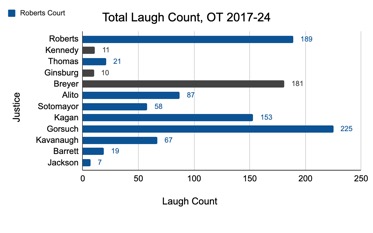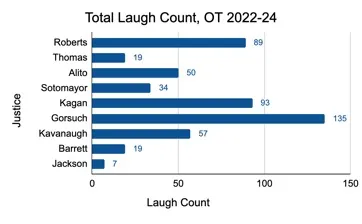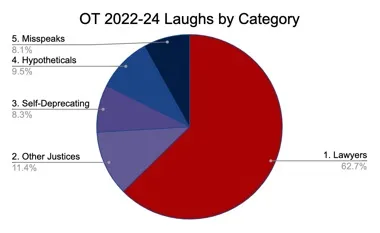JUSTICE GORSUCH: So you will have a canine within the hunt on the scope of the invention rule —
MR. EARNHARDT: Effectively —
JUSTICE GORSUCH: — however not on whether or not there’s a discovery rule?
MR. EARNHARDT: Effectively, no, I —
JUSTICE GORSUCH: Is that what you’re saying?
MR. EARNHARDT: No, I’m saying —
JUSTICE GORSUCH: The place is that this canine? (Laughter.)
The Supreme Court docket’s oral arguments are, at their core, workouts in superior authorized reasoning – disputes over constitutional boundaries, statutory ambiguities, and the very construction of American governance. But amid the seriousness of the instances argued, oral arguments can embody moments of levity. Justices will throw in a one-liner or well-timed quip that prompts guffaws – typically at their very own expense, typically at an advocate’s, and typically simply because the second requires it.
Now that the Supreme Court docket’s new time period is about to start, we thought it could be an excellent time to (quickly) abandon the extra critical aspect of issues and dig into two questions: First, who precisely is the funniest justice? And second, what sort of humor do the justices make use of?
Answering these questions not solely supplies perception into the character of the individuals who sit on the bench, but additionally helps to shed some gentle on what is usually a relatively opaque establishment. And, in fact, it’s additionally simply plain entertaining.
Previous laughs
As Justice Samuel Alito has said, “there are some individuals who don’t have anything higher to do than depend Supreme Court docket laughs.”
And certainly, quantifying humor on the Supreme Court docket is just not a novel endeavor. Authorized students – who’ve acknowledged that they’ve some free time on their arms – have, in phrases previous, pored over the moments marked unceremoniously as “(Laughter.)” on argument transcripts.
The OG was regulation professor Jay Wexler, who supplied an analysis for The Inexperienced Bag, which was then picked up by New York Instances reporter Adam Liptak on what Wexler surmised to be “a lightweight information day.” 5 years later, in 2011, Liptak covered an identical research by Ryan Malphurs, who criticized Wexler’s methodology. (That stated, each nonetheless discovered Justice Antonin Scalia to be the funniest justice on the courtroom on the time.)
Over time, extra research adopted. In 2019, regulation professors Tonja Jacobi and Matthew Sag printed “Taking Laughter Seriously at the Supreme Court,” an evaluation for the Vanderbilt Regulation Evaluate of over 9,000 events between 1955 and 2017 during which the courtroom gallery laughed. Amongst different issues, the authors discovered that the justices, versus the advocates, equipped round 68% of the humor.
Extra just lately, a 2020 study by Siyu Li and Tom Pryor in Regulation & Coverage added that attorneys who elicit laughter might achieve votes, influenced by case complexity and argument energy. Within the authors’ phrases: “[T]he impact of laughter is conditional—it exerts a heightened persuasive energy on ideologically congruent justices, in noncomplex instances, and when the authorized argumentation is of upper high quality.” Or one thing.
So who’s humorous now?
In fact, since 2020, issues have modified – at first being the courtroom’s dynamics.
Maybe most notably, the comedian of much of the Roberts era – Justice Stephen Breyer – left the courtroom in 2022. Identified for his prolonged hypotheticals, Breyer additionally had a present for utilizing comedy, typically unintentionally, to check the boundaries of authorized reasoning. Some hypotheticals, for. instance, involved “tomatoes which might be going to have genomes in them that might, sooner or later, result in tomato youngsters that can finally have an effect on Boston,” and futuristic administrative inspections of personal spaceships (although Breyer clarified that “[t]hey had no spaceships at widespread regulation”).
However, extra importantly, who’s the reigning comedic champion in the present day?
To determine this out, I reviewed every oral argument transcript from the 2022-23 by means of 2024-25 phrases (the primary full three years of the Roberts courtroom with Justice Ketanji Brown Jackson and with out Breyer), counting and categorizing every of the 503 situations of “Laughter” based mostly on the previous justice’s comment.
This yielded a transparent winner: Justice Neil Gorsuch, with a formidable 135 laughs. He was adopted by Justice Elena Kagan with 93 and Chief Justice John Roberts with 89 – considerably confirming Sen. Chuck Schumer’s prediction throughout Kagan’s nomination hearings that she would “give [Scalia] a run for his cash” when it comes to laughs.
As for the remainder of them: Justice Brett Kavanaugh (57) and Alito (50) trailed behind, whereas Justice Sonia Sotomayor garnered 34 chuckles. Justices Clarence Thomas (19), Amy Coney Barrett (19), and Jackson (7) elicited the fewest, a sample that will mirror their extra reserved argumentative types and Jackson’s comparatively brief time on the courtroom.
For broader context, I additionally tallied laughs between the 2017-18 and the 2024-25 phrases. Gorsuch as soon as once more got here out on prime (at 225 laughs) with Roberts in second (at 189 laughs). Once more, Kagan wasn’t too far behind, at 153. However the remainder of the bench trailed considerably, with all different justices remaining within the double digits.
See for your self:


Forms of humor
That’s our funniest justice, however uncooked counts of how a lot laughter every justice will get inform solely half the story. The kind of humor justices make use of has been studied much less however is simply as fascinating (effectively, at the very least to us at SCOTUSblog). After going by means of the transcripts, I discovered that the sorts of humor can usually be sorted into 5 classes:
- Making enjoyable of the attorneys;
- Making enjoyable of fellow justices;
- A self-deprecating joke;
- Hypotheticals illuminating absurdity;
- Misspeaks or unintended interruptions.
Because the chart under illustrates, the commonest kind of humor targets the attorneys (Class 1). That is maybe not stunning since, effectively, the attorneys do a complete lot of speaking (if the justices enable them to). On a darker observe, this will additionally consequence from Jacobi and Sag’s emphasis on energy imbalances: Though it’s the attorneys who’ve the microphone, it’s the justices who decide the narrative and might use the attorneys as pawns, typically by means of ridicule, to take action.

Under I illustrate these classes by means of some alternatives from the 2023-24 and 2024-25 phrases.
Class 1: Making enjoyable of the attorneys
As famous above, the commonest kind of humor was making enjoyable of the attorneys, normally by specializing in flaws of their arguments, a tactic particularly favored by Kavanaugh (82% of his laughs) and Gorsuch (75%). However in United States v. Rahimi, difficult a gun ban for home abusers, Roberts additionally took a flip at this when urgent the advocate on the defendant’s dangerousness:
CHIEF JUSTICE ROBERTS: Effectively, to the extent that’s pertinent, you don’t have any doubt that your shopper’s a harmful individual, do you?
MR. WRIGHT: Your Honor, I’d wish to know what “harmful individual” means. In the intervening time —
CHIEF JUSTICE ROBERTS: Effectively, it means somebody who’s taking pictures, you already know, at folks. That’s an excellent begin. (Laughter.)
Class 2: Making enjoyable of the (different) justices
Bench-on-bench banter, at 11% general, might expose tensions between the justices, however different occasions reveals the collegial nature of the courtroom. Jackson led on this class (29% of her laughs), usually archly summarizing the positions of her colleagues. On a (considerably) extra collegial observe was this change in Wilkinson v. Garland, led by Alito:
JUSTICE ALITO: … However, in the event you ask an unusual individual, you set out a sure set of information, so let’s say I’m complaining about my office, it’s chilly, it’s set at 63 levels, there isn’t any espresso machine, the boss is unfriendly, all my coworkers are obnoxious, and — and also you say am I experiencing — (Laughter.)
JUSTICE ALITO: No, I’m not — (Laughter.)
JUSTICE BARRETT: Okay. (Laughter.)
JUSTICE ALITO: Any resemblance to any residing character is solely — purely unintended. (Laughter.)
Class 3: A self-deprecating joke
Often, the justices will poke enjoyable at themselves relatively than the advocates or their colleagues. Thomas had the best share of this (18% of his laughs), however Gorsuch had the very best uncooked variety of self-deprecating laughs (at 14). In Trump v. CASA, for instance, on district courts’ energy to subject nationwide injunctions, Gorsuch engaged within the following change:
MR. FEIGENBAUM: So I do really feel like one thing of an amicus to this query as a result of nothing in my injunction rises or falls on this declare bucket.
JUSTICE GORSUCH: Precisely. So — so —
MR. FEIGENBAUM: However — so I’m completely happy to reply questions on that.
JUSTICE GORSUCH: — I — I would like all of the amici I can get. (Laughter.)
Class 4: Hypotheticals
Members of the courtroom at occasions have utilized absurd extensions of advocates’ arguments in an effort to reveal flaws in these arguments. This was performed mostly by Barrett. However Kagan was no stranger to this type of humor both. In FCC v. Consumers’ Research, on company funding, she had the next to say:
JUSTICE KAGAN: Once more, you — once more, you — you’re saying that we must always interpret this statute to say that that phrase, “ample,” is just not imposing a requirement, which means ample, what’s required to do these companies, however no more than that?
MR. McCOTTER: Sure, as a result of that’s what the FCC itself has stated for 30 years.
JUSTICE KAGAN: Okay. I’ll add that to my record to issues that I feel can be an unreasonable statutory interpretation. Sufficiency means — like after I name the pizza operator and say: I need you to ship me pizza ample for 10 folks, after which an 18 wheeler reveals up — (Laughter.) — that’s not an correct understanding of what I requested for. (Laughter.)
Class 5: Misspeak/Interruptions
And, lastly, there are pure talking or timing errors. Roberts leads on this class, doubtless on account of his function as chief justice, placing him answerable for when the opposite justices and advocates might communicate. Take this “change” from Brown v. United States:
JUSTICE KAGAN: Mr. Raynor —
JUSTICE KAVANAUGH: Sorry.
JUSTICE KAGAN: I’m sorry. Go forward.
JUSTICE KAVANAUGH: Go forward.
JUSTICE KAGAN: No, you — you had been first.
JUSTICE KAVANAUGH: Go forward.
CHIEF JUSTICE ROBERTS: Justice Kagan. (Laughter.)
CHIEF JUSTICE ROBERTS: Justice Kagan.
JUSTICE KAGAN: Can I take you again to the dialog that…
The underside line
So, apart from offering some (comparatively uncommon) courtroom leisure, the place does this get us?
As others have beforehand famous, laughs within the Supreme Court docket are usually not essentially benign: They’ll and do empower, persuade, and divide. However that’s not all. Such levity also can remind us of the justices’ humanity; that they’re individuals who make good (and dangerous) jokes, identical to the remainder of us. And, in a time the place many voters view these with differing ideologies as caricatures relatively than human beings, such a reminder isn’t any laughing matter.
Posted in Court Analysis, Featured
Advisable Quotation:
Nora Collins,
The funniest justice,
SCOTUSblog (Sep. 24, 2025, 11:34 AM),
https://www.scotusblog.com/2025/09/the-funniest-justice/
